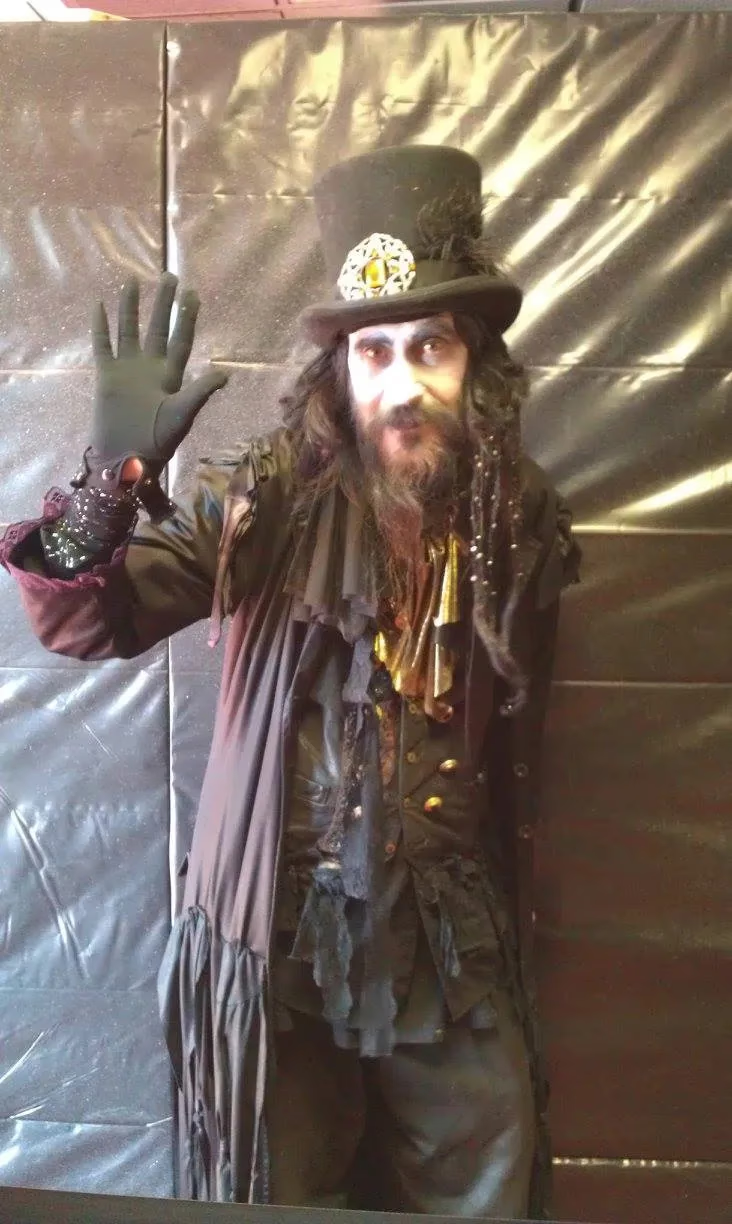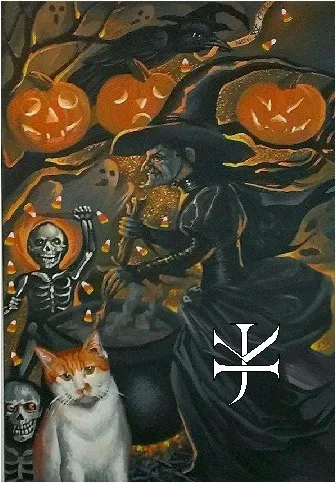A Ghost You Could Touch: Remembering Rutherford NJ’s Favorite Pirate Joseph Kozak (AKA Francois)
Published on April 2, 2025


Hey, I’m Sal - but most people know me as Social Gal. I chase chaos, beauty, and big energy across New Jersey, turning late-night comedy sets, underground art shows, and hometown legends into stories that *hit*. If it’s weird, raw, or lowkey iconic, I’m already three steps ahead with a notebook and a hot take. I almost died after being diagnosed with heart cancer and documented it all on online in hopes I could leave something behind if I die. Surprisingly, I survived but my love for documentation never died. I came out louder, bolder, and more in love with life than ever. I believe the best stories aren’t polished - they’re real, messy, and full of soul. That’s what I bring to NJ Radar. Catch me wherever the vibes are real, the people are unfiltered, and the stories *actually matter*.
A Ghost You Could Touch: Remembering Rutherford NJ’s Favorite Pirate Joseph Kozak
Always the Wrong Time Period
While the rest of us shuffled along in hoodies and headphones, Joseph Kozac (AKA Francois) walked the streets of Rutherford dressed like the 1600s never ended - lace, brocade, pearls, powdered skin peeling like ghostflesh in July heat.
We called him the “pirate guy.”
But let’s be clear - he wasn’t playing dress-up. He was remembering. And for some of us? He was the first living example that you could be weird as hell and still survive.
Francois didn’t belong to this world and he’d be the first to say it.
He was a living protest against the death of individuality, a time-traveling oracle warning us that the soul was in danger and the machines were winning.
Some people honked, some people laughed, some people yelled slurs from passing cars - but the children? The children always knew. They asked the real questions. They weren’t mocking him. They were curious and shockingly way more human than the average joe.
I grew up in the same town as the costume shop where Francois worked - Fun Ghoul. A name that already sounds like a place between worlds. And walking past its windows, seeing Francois just being himself - draped in history, daring the present to flinch - made me believe I could be myself too. Not a watered-down version. Not a safe version. Just...weird, free, and whole. He wasn’t trying to make a statement. He was the statement. And now that he’s gone, it feels like the sky is missing one of its weirdest, brightest stars.
But this is not a eulogy - this is a resurrection.
Let me tell you who he really was.
WHO WAS FRANCOIS? (Aka: The Medium on the Bus)
He called himself Francois, and titles like "artist" or "medium" don’t do him justice. He was a walking contradiction - a 17th-century ghost riding a 21st-century NJ Transit bus.
He didn’t own a phone. Didn’t touch a computer. He’d step onto the 190 line in full aristocratic regalia like it was Versailles on wheels. Lace cuffs. Gold trim. Makeup that looked like rot and ritual.
People stared. They always stared.
Some yelled, “ARGH!” Others shouted, “Where’s your parrot?” A few hurled words like “freak” or “Satanico.” But Francois just kept walking, boots clicking down the concrete like the past refused to die.
He worked at Fun Ghoul Costume Shop - his personal sanctuary, his wardrobe of memory. It wasn’t just a job. It was a safe zone, a soft place for someone who spent most of his day running a gauntlet of stares, slurs, and assumptions. But even there, he didn’t hide. He dressed the same on the job, off the clock, on hot summer days where most people stripped down.
“Summer is for silks and lace,” he’d say.
“I never said I was here to be comfortable.”
To the outside world, Francois was a curiosity. A novelty. But to those who actually listened? To the children, to the ghosts, to the weirdos who saw themselves in him? He was something else entirely.
A time-traveler. A messenger. A medium.

He didn’t just wear the past either, he channeled it.
He said the voices came to him in French. He didn’t even speak French. But they gave him names and stories. People who had died in the Revolution. Aristocrats, children, loyalists begging for masses to be said in their honor. Francois listened and wrote their names phonetically, took them to the church, and the church, recognizing the names, agreed to hold the masses.
Afterward, he said, “it felt like a weight had been lifted.”
Francois also saw conspiracy not as theory, but as memory. He spoke of “the mark of the beast,” of Kindles replacing books, of people losing their souls to a faceless digital god. To most people, it sounded apocalyptic, but to Francois, it was just obvious.
“They’re bragging about getting rid of books. With something called Kindle. What do you do with kindling? You start a fire.”
He called Fahrenheit 451 a prophecy. He warned of the coming burn, not just of books, but of identity. And when you saw him standing there in full 1700s glamour, sweating through silk but refusing to blend in, you started to understand: This was an act of protest.
“Anything that has real character, individuality, or personal expression is becoming this big faceless digital blob,” he said.
“If we’re not here to be individuals, then there’s no purpose for us to be here.”
And in doing so, he made this plastic world feel thin.
He reminded us: not everything belongs to the now.
The Artist with a Walk-In Closet of Worlds
To say Francois painted is an understatement.
His paintings were portals. Each piece was a gothic relic pulled from another realm - part sermon, part exorcism, part whispered memory from beneath the floorboards.
If you want to understand him, don’t look at his face. Look at his art. What you’ll see isn’t meant to soothe you. It’s meant to wake you up. To show you the parts of the human condition that polite society likes to bleach out - death, pain, memory, madness, God, rot, rebirth.
It’s all there and it’s all sacred.
🩸 Skulls with skin webbing like cracked halos
🩸 Children wrapped in barbed wire, guarded by ribcage skeleton angels
🩸 Baroque demons with the faces of the forgotten
🩸 Pumpkin-eyed spirits beside black-robed witches and grinning cats that see too much
🩸 Himself - painted in elegance, surrounded by ghosts of influence, holding a boot like an artifact of survival
Every piece is heavy with symbolism: Catholic horror meets Romantic decay, childhood innocence caged in flame, flesh as relic, death as witness. It’s theology. It’s grief theory. It’s autobiography through bone and brush.
This was someone who didn’t separate his art from his existence. His paintings were the same spell as his wardrobe, his presence, his public haunting. He didn’t live like an artist. He was art. It wasn’t meant for mass approval. It was for the dead. For the survivors. For the ones who felt too much and were told to quiet down. For those of us who’ve stared into the void and seen something…familiar.
The Haunted Canvas: Selected Works by Francois

What He Gave Us
Francois never asked to be a symbol.
But the second he walked out the door in a powdered wig and brocade jacket, he became one. For the quiet weirdos. For the genderfucked and time-lost. For the outcasts who never saw someone like them thriving in plain sight.
He gave us permission.
To be strange. To be seen. To walk through a hostile world dressed like a fever dream and dare it to look away. He gave us a mirror - not of what we were, but of what we could be if we let go of fear. For people like me - who grew up walking past Fun Ghoul and catching glimpses of this baroque ghost in the flesh -he cracked the illusion open. He showed us that you don’t have to wait for Halloween to dress like a legend. You don’t have to tone it down to survive. You don’t have to be palatable to be powerful.
“Who are you supposed to be to make everyone else happy?” he said. “No matter where I go, people say, ‘Why are you here?’ But in the way that it counts, I feel connected to history.”
He didn’t blend in. He didn’t back down. Even when it hurt. Even when it cost him. Francois walked through this world like an act of rebellion wrapped in lace and bone.
That act - day after day - liberated people, ESPECIALLY us kids! You didn’t have to know him personally to feel the effect. His presence was a rupture in the pattern. A reminder that authenticity is worth bleeding for.
A living challenge: What would you wear if you weren’t afraid?
Who would you be if you stopped shrinking?
He didn’t just serve us a look. He gave us courage.
His Legacy - A Warning, A Gift
Francois didn’t come here to fit in.
He came here to remind us that time is an illusion. That fashion can be armor. That ghosts carry truths. That individuality is not a trend, it’s resistance. “If I’m gonna go down, I’m gonna go down as an aristocrat.”
He meant that.
He saw what the rest of us tried not to: The world is being flattened. Stripped of its soul. Turned into a grid of screens and sameness, where nothing has texture, ritual, or mystery. Where books are deleted, faces are scanned, and everything weird gets filtered out. And in the middle of that digital erasure, Francois stood a glitch in the matrix wearing pearls. He was the human embodiment of "you can’t sanitize the sacred."
He saw where this was all heading. He warned us that what was coming wouldn’t look like war - it would look like convenience. It would feel normal. It would feel easier. And that’s why it would be dangerous. He was the kind of person people mock when they're alive, then revere when it’s too late. But the real ones? We knew. We felt it. He wasn’t out of place. He was ahead of his time. Francois left us with more than beautiful paintings and whispered prophecies. He left us with a question: Will you die a copy, or live as an original?
The Wrong Time, The Right Spirit
They said he was in the wrong time period.
He said, “It’s always the wrong time period.”
Maybe that was the point. Francois didn’t dress like that to be eccentric. He wasn’t doing it for Halloween, or for art school cred, or to make a scene. He did it because it was the only way to live truthfully in a world that kept trying to pixelate the soul.
And now that he’s gone, Park Ave feels quieter. Too quiet.
No powdered silhouette moving through the mist.
No rhinestones reflecting the streetlight.
No 17th-century ghost reminding us, just by being, that there is more to this life than errands and email.
But he’s not really gone. Because anyone who ever saw him - really saw him - carries him forward. In the way they dress. In the way they resist. In the way they dare to exist loudly, weirdly, unapologetically - no matter who stares.
Francois was never trying to live forever. But now he’s immortal.
In every artist who paints their nightmares. In every kid who walks out of their house dressed “wrong” and keeps walking anyway. In every whisper that says, don’t blend in. don’t back down. don't forget the ghosts.
So light a candle. Blast some baroque music. Put on the outfit that makes your neighbors uncomfortable. And if someone honks or shouts, “ARGH!” from a passing car?
Smile.
Because you are not lost. You are haunted. And that’s holy.
🕯️ For Francois.
Rutherford’s time traveler.
The ghost who walked among us.
Sources: Weird NJ, Joseph Kozak’s facebook page